Silkworm Rearing:
The following information is all about Silkworm Rearing.
Introduction To Silkworm Rearing
What is silkworm rearing? well, it is part of sericulture in which worms are raised for the production of raw silk. When it comes to the definition of the silkworm, it is the larva or caterpillar of the “Bombyx mori” moth. Silk worms are native to chine and they feed on mulberry leaves. For commercial silkworm farming, you should also consider growing a mulberry crop. Usually, a female silkworm lays about 500 to 600 eggs on mulberry leaves before it dies ( As these silkworms won’t eat anything after egg laying which results in silkworms death). These silkworm eggs are hatched into larva in cool and favorable conditions. In the following sections, let us discuss more silkworm rearing process.
Silkworm Scientific/Botanical Name
- Bombyx mori.
Silkworm Family Name
- Bomabycidae.
Silkworm Common Names in India
रेशमी का कीड़ा : Hindi.
పట్టునూలు పురుగు : Telugu.
பட்டுப்புழு : Tamil.
പട്ടുവം : Malayalam.
ರೇಷ್ಮೆ ಹುಳು : Kannada.
रेशीम किड : Marathi.
ਰੇਸ਼ਮ ਕੀੜੇ : Punjabi.
રેશક વોર્મ : Gujarati.
রেশমগুটি : Bengali.
ریشم کے کیڑوں : Urdu.
The lifecycle of Silkworm Rearing
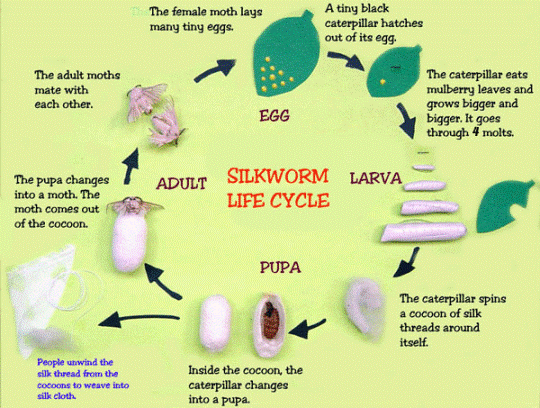
Chawki Rearing in Silkworm Rearing
What is Chawki rearing? well, generally the silkworms pass through 5 developing phases (Instars) from their hatching to the full-developed stage. In this process, the silkworms up to the second stage (stage 2) are called Chawki or young age worms. The young worms or Chawki requires special care and attention as they are very much prone to infections and vulnerable to unfavorable climatic conditions. This is the reason why most people rear the Chawki in separate Chawki rearing centers under a controlled environment (conditions). The rearing practices of young worms (Chawki) are completely different from late age rearing worms.
Late Age Rearing in Silkworm Rearing
What is late age rearing? well, as we have already mentioned above that the lifecycle of silkworms till the second stage is known as “Chawki”. From third stage development (from 3rd instars), worms are being known as late age rearing. The late age rearing worms engage in heavy feed consumption. However, late age rearing of worms requires different practices.
Read: Sericulture Training in India.
Rearing House in Silkworm Rearing
The silkworm rearing house must have a controlled environment for rearing Chawki and Late age silkworms. The conditions like temperature and relative humidity (RH) should be maintained 24°C to 27°C and 75% to 85% respectively. It is mandatory to provide a rearing house with appropriate cooling through proper selection of wall material, roof fabrication, building direction (orientation), method of build construction, design of rearing house, etc. You must also ensure sufficient space for mulberry leaf preservation, Chawki rearing, late age rearing, and molting. The rearing house should be designed in such a way that it can be cleaned and disinfected with ease. When it comes to the size of the rearing house, generally it depends upon number (quantum) and method of rearing. Usually, a floor area of 400 to 500 square feet can provide rearing space for 100 to 110 dfls (dfl: Disease Free Layings; 1 dfl = 500 larvae).
Rearing Appliances in Silkworm Rearing
The late age silkworm rearing house must have good cross-ventilation to bring down the house temperature and for removal of vapors and unfavorable or harmful gases generated from large quantities of silkworms excreta.
The rearing equipment/appliances required for 100 dfls (1 dfl = 500 larvae, so 100 x 500 = 50,000 larvae) is as follows (in Table ):

Disinfection in Silkworm Rearing
The rearing house and appliances/equipment should be disinfected thoroughly after the completion of the previous crop and just two days before the next crop respectively. The first disinfection should be carried out once with 5% bleaching powder, this should be done as soon as the previous crop is completed. The next disinfection should be carried out with 2.5% Chlorine dioxide solution two days after the next crop.
The following table is a disinfection schedule of rearing house and appliances.
| Day | Order of work | Work details |
| After the completion of previous crop rearing | 1 | This should involve the collection and burning of diseased larvae and melted, and flimsy cocoons. |
| 2 | Flaming the floss of rotary mountange and disinfection by fumigation should be carried out. | |
| 3 | First disinfection of rearing house and appliances should be carried out. | |
| 5 days before brushing | 4 | Cleaning and washing of appliances should be carried out. |
| 5 | Sun drying of appliances should be done. | |
| 4 days before brushing | 6 | Disinfection of rearing with 0.3% slaked lime (optional) should be carried out. |
| 3 days before brushing | 7 | Second disinfection of rearing house and appliances should be done. |
| 2 days before brushing | 8 | Dusting disinfectant in front of rearing house and to the passage should be carried out. |
| 9 | Opening the windows of rearing house for ventilation should be carried out. | |
| 1 day before brushing | 10 | Preparation for brushing should be done. |
Shoot Rearing of Silkworm Rearing
In the shoot rearing method, the final three stages of rearing will be carried out by providing mulberry shoots instead of individual mulberry leaves. This method of rearing is recommended since it saves about 40 to 45% of rearing labor. The other benefits of this method include:
- This method of rearing drastically reduces the contamination and disease spread as there is minimal handling of silkworms.
- As worms and leaves are separated from feces, the secondary contamination is also reduced to a great extent.
- This method provides the maintenance of hygienic conditions in the rearing house.
- The shoot rearing method provides better preservation of leaf quality.
- It also provides better aeration in the bed during rearing.
- Another advantage of this method is better cocoon quality and higher survival of larvae.
- This is more economical and results in less non-recurring expenditure.
Feeding in Silkworm Rearing
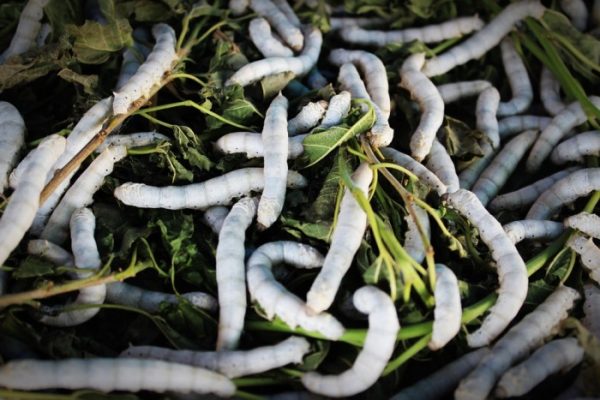
- Feeding should be started off with 50 days old shoots harvested at the height of 3 feet in the cooler hours of the morning. 60 days old shoots should be fed to 5th stage worms.
- Make sure to preserve the harvested shoots loosely in the vertical position in a cool and moist place. This can be done by covering with cleaned, disinfected and wet gunny cloth.
- The amount or quantity of mulberry shoot required is 460 to 470 Kg in fourth instars and 2880 to 2900 Kg in fifth instars for bivoltine silkworms.
- You should carry daily 3 feeds (morning 6 am, afternoon at 2 pm and night at 10 pm).
- It is advised to avoid feeding over matured mulberry leaves.
- Make sure to distribute the larvae uniformly on the bed during every feeding. The recommended bed space for the worms of 100 dfls at the end of the 5th stage is about 600 to 650 square feet.
- To prevent any contamination, you should remove the undersized and all suspected diseased worms carefully with chopsticks before every feeding/cleaning. Make sure to place the picked larvae in 2% bleaching powder in 0.3% slaked lime solution.
Bed Cleaning
- Make sure to remove any unhealthy larvae from the bed, if any and put them into 2% bleaching powder in 0.3% slaked lime solution.
- Care should be taken while cleaning the bed and do not spill the bed refuses on the floor of the rearing house/room.
Temperature and Humidity
- The optimal temperature for the late age silkworm rearing is about 26°C for 3rd instars larvae, 25°C for 4th instars and 24°C for 5th instars larvae. 80 to 85% humidity should be provided for III instars larvae and 70 to 75 % humidity is required for fourth and fifth instars larvae.
- You should use coolers, wet gunny cloth, heaters and humidifiers to adjust the temperature and relative humidity as per requirement.
- It is essential to have good cross ventilation which can help to reduce the body temperature of the rearing silkworms.
Read: Sericulture Subsidy and Loan in India.
Care During Moulting
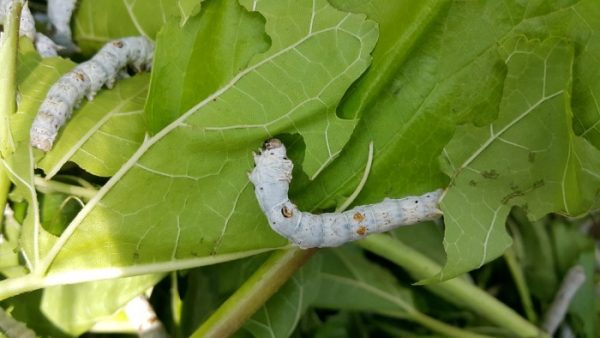
- The rearing house should have good cross ventilation and dry conditions, especially during moulting period.
- Make sure to spread the bed gently soon after the worms settle for moult. Apply the slaked lime powder uniformly over the bed for drying the bed.
- Rearing house should not go through temperature fluctuations and humidity fluctuations. Strong winds surroundings of rearing house should be avoided.
- Avoid bright light in worm rearing room.
- You should continue feeding when 90 to 95% of worms come out of moult.
Maintenance Of Hygiene in Silkworm Rearing
- Maintaining personal hygiene is important during silkworm rearing. You should wash hands & feet with a disinfectant solution before entering the rearing house.
- You should also wash hands with disinfectant solution and water after picking of diseased worms from the bed, after bed cleaning and before feeding the worms.
- You should pick the diseased silkworms daily and place into a basin with lime powder and bleaching powder mixture. These dead worms should be disposed of carefully by burying far from the rearing room.
- You should always maintain the silkworm rearing room clean and well-aerated.
Application Of Bed Disinfectant
The following are silkworm body and rearing bed/seat disinfectants used in preventing any silkworm diseases.
- Vijetha.
- Vijetha Green.
- Ankush.
You should take the powder in a thin cloth and dust over the silkworms @ 5 grams per square feet area after every moult. Subsequently, once on the fourth day of final instar after bed cleaning. See the below table for schedule and quantity to be dusted for 100 dfls.

- You should NOT dust when worms are under moult or on eatable mulberry leaves.
- Make sure to feed worms 30 minutes after dusting.
- During rainy and winter seasons use Vijetha supplement to prevent silkworms from muscardine disease.
Mounting Of Ripened Worms
To yield quality cocoons, mounting the larvae of the silkworm at a suitable time and good quality mountages are very important tasks. Generally, In the 5th instars on 7th-day silkworms enter into maturation and stop feeding, and start to search place to build the cocoons. Those larvae should be collected immediately and mounted on to the mountages. It is essential that the number of larvae on mountages must not exceed the capacity of each mountage. When the larvae are in the spinning stage, ensure the room temperature of 24°C and 65 to 70 % of RH (Relative humidity) along with good aeration. You should provide rotary mountages for the production of good quality cocoons. About 35 sets of rotary mountages should be required for mounting silkworms of 100 dfls.
Harvesting And Sorting in Silkworm Rearing
Usually, cocoons are harvested on the sixth day. You should remove defective cocoons and sort out the cocoons, grade the cocoons according to the quality. Delaying harvest of cocoons by 1 day in winter is advised.
Cocoon Yield in Silkworm Rearing
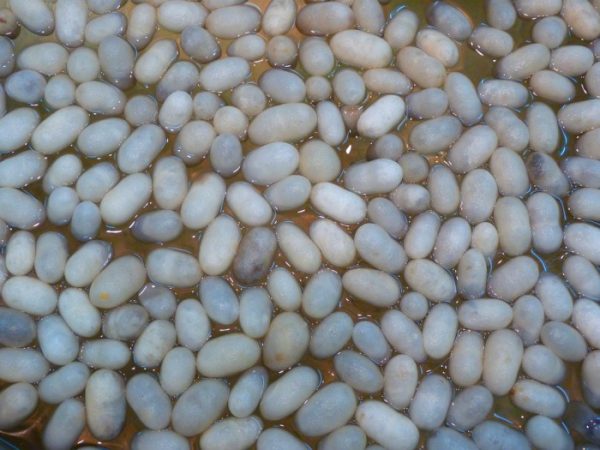
The yield of cocoons depends upon the rearing practices of silkworms. On an average one can obtain a yield of 65 to 70 Kg cocoons from 100 dfls. About 800 to 900 Kg cocoons can be harvested from 1 acre of mulberry orchard per year.
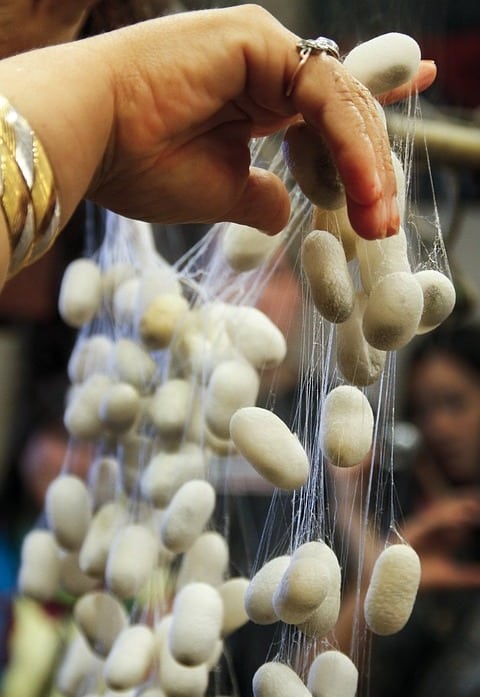
Marketing in Silkworm Rearing
It is recommended to transport the cocoons during the morning or late evening cooler hours (market on the seventh day). Cocoons should be loosely packed in 35 to 40 kg capacity nylon netted bags. Make sure the transport vehicle has shelves/partitions to avoid any pressings of cocoons.